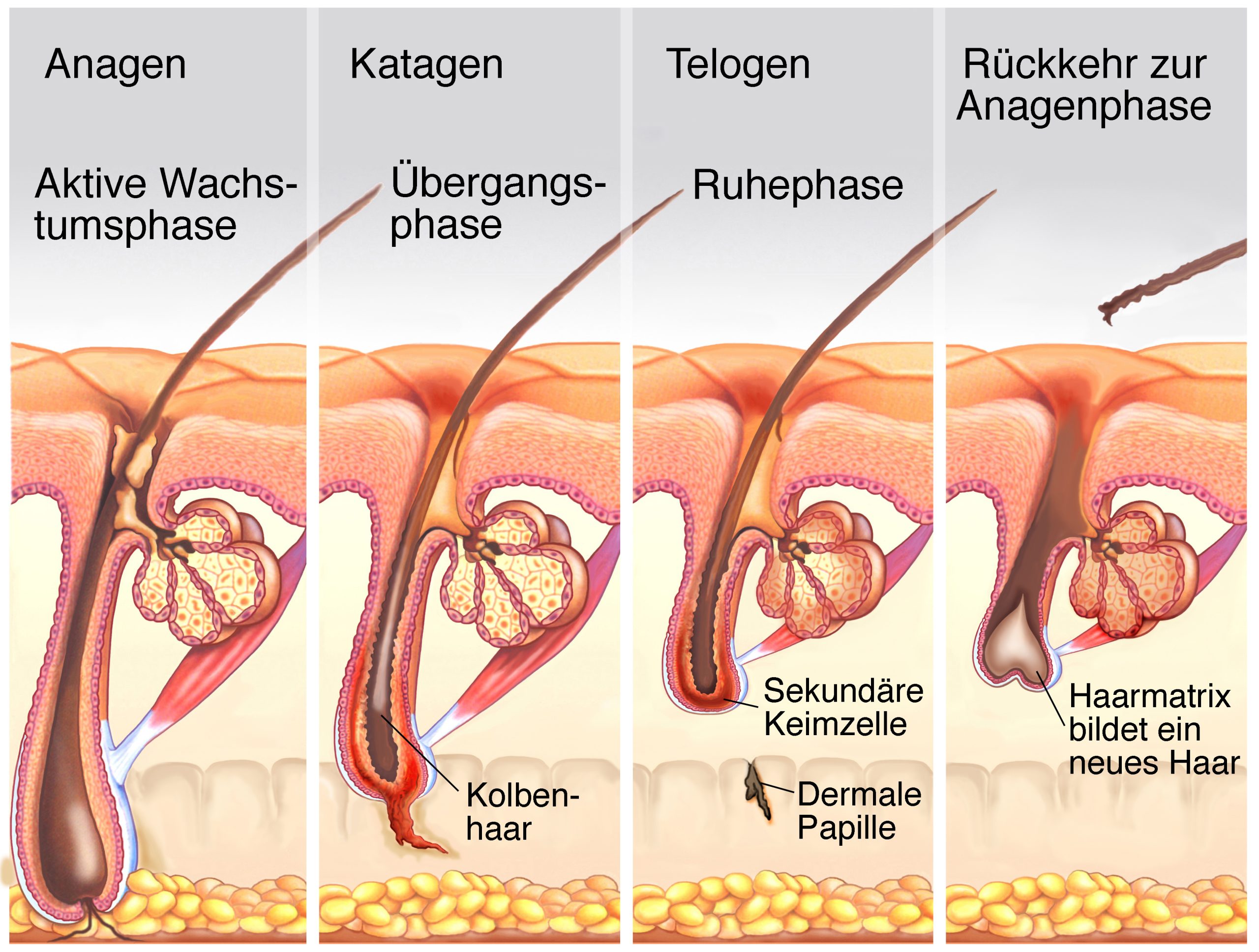With the help of platelet-rich plasma (PRP), hair loss can often be stopped or even reversed. In the PRP treatment for hair loss, growth factors from the patient’s own blood are administered to the scalp, thus prolonging the growth phase of the hair roots or stimulating hair growth.
Plasma therapy with PRP is also recommended after a hair transplant to ensure successful growth of the transplanted hair. The PRP therapy represents a very natural and effective complementary therapy here, as no foreign substances are used in this procedure.
Important Facts
- Treatment duration: 30 minutes
- Anesthesia: Local anesthetic cooling spray if needed
- Aftercare: None
- Result: Continuous stimulation of hair growth over weeks to months, multiple sessions necessary.
- Pain level: Low, only tiny punctures with very fine cannulas
- Social downtime: Immediate, rarely small crusts possible
- Price: 280€
Hair Growth and Hair Loss
The Hair Cycle
It’s completely normal for some hair to fall out daily, and this is due to the natural growth cycle of human hair. A human hair follicle repeatedly goes through three different phases that make up the natural hair cycle.

1. The Anagen Phase or Growth Phase
Normally, about 80%-85% of the hair on the head is in this phase. During the anagen phase, the hair grows, on average about 1cm per month. This phase lasts between 2 and a maximum of 6 years for most people. This is why most people can’t grow infinitely long hair – Rapunzel is just a fairy tale after all. After a maximum of six years, each hair in most of us ends its growth cycle and enters the so-called catagen phase.
2. The Catagen Phase or Transition Phase
This lasts about 2 weeks. The hair root undergoes various restructuring processes and hair growth comes to a halt. About 1-2% of the hair on the scalp is normally in this phase. The hair detaches from the hair follicle in the deeper layers.
3. The Telogen Phase or Resting Phase
In this phase, the hair finally falls out. About 18% of hair follicles are usually in the telogen phase, and it lasts 2-3 months. Now the hair papilla renews itself and the hair follicle regenerates, so that at the end the anagen phase begins again, in which a new hair can grow.
When Is It Considered Hair Loss?
Up to 100 hairs per day are considered normal, and temporarily it can be a bit more without it being a problem. For example, slightly more hair falls out in spring and autumn than in summer and winter. But when significantly more hair falls out over a longer period, it’s usually not a good sign.
Men and women affected by increasing thinning of hair are often very concerned. With every look in the mirror or after every wash and brush of the hair, everything is critically eyed and checked. After all, hair is considered a mark of attractiveness in our society and a sign of youth.
Types of Hair Loss and Possible Causes?
Basically, a distinction is made between so-called hereditary hair loss, also known as androgenetic alopecia, which can affect both men and women, and diffuse hair loss, which can also occur in both genders.
Androgenetic Alopecia
The so-called androgenetic alopecia (AGA), also known as hereditary hair loss, is the most common form of hair loss. Although it occurs in both genders, men are far more frequently affected. Usually, a familial clustering of the condition is observed, with the father and grandfather of the affected person already suffering from thinning hair.
Initially, the typical receding hairline forms at the sides of the forehead, and with increasing age, the hair on the back of the head (tonsure) also thins out until finally only a horseshoe-shaped ring of hair remains in the final stage. In the end stage, complete baldness occurs.
For most men, these changes typically begin between the ages of 30 and 40.
When women are affected by androgenetic alopecia, the increasing hair loss is mainly seen in a widening of the parting and much less frequently in the formation of receding hairlines.
Causes of Androgenetic Alopecia
The cause in both genders is an increased sensitivity of the hair follicles to male sex hormones. The hair roots develop a hypersensitivity to DHT (dihydrotestosterone), the active form of testosterone, resulting in increased hair loss.
This is also the reason why women are often only affected by androgenetic alopecia during menopause, because then the hormone estrogen, which normally helps counteract the effects of testosterone, declines.
What Treatment Options are Available for Androgenetic Alopecia?
Admittedly, baldness suits some men very well, but not everyone wants to accept hair loss.
The treatment options available so far are, on one hand, oral therapy with Finasteride for men, a medication that inhibits the conversion of testosterone to DHT, and on the other hand, local therapy with Minoxidil. However, Finasteride is suspected of causing potency problems, while Minoxidil requires application once or twice daily, which many patients find very annoying. For women in menopause, hormone replacement therapy should also be considered in consultation with a gynecologist.
For many affected men, the last step is often autologous hair transplantation. This is also the only alternative when no living hair follicles remain and hair loss has progressed very far. However, this is a relatively expensive option.
Diffuse Hair Loss
Diffuse hair loss, also called telogen effluvium, occurs in phases. Unlike hereditary or genetically predisposed hair loss, the entire scalp is affected here and there are no preferred areas or recognizable hair loss patterns. Rather, the entire head of hair thins out and becomes sparser. Again, both men and women can be affected. The characteristic is that the hair cycle becomes unbalanced periodically or permanently, and the proportion of hair follicles in the telogen phase increases. The duration of the phenomenon varies from person to person.
Causes of Diffuse Hair Loss
Unlike androgenetic alopecia, the causes of diffuse hair loss are not genetic, but lie in the life circumstances of the affected patients.
Possible triggers of diffuse hair loss can be:
- Diets
- Birth control pills
- Physical or psychological stress
- Lack of sleep
- Smoking
- Infections (diffuse hair loss often occurs after a COVID-19 infection)
- Nutrient deficiencies (iron, zinc, B vitamins)
- Hormonal changes (pregnancy/childbirth/breastfeeding)
- Thyroid problems
- Certain medications (for example, blood-thinning substances)

PRP Treatment for Hair Loss - A Promising Therapy
Platelet-rich plasma (PRP) represents a 100% natural, low-risk, and easily administered treatment alternative that, according to studies, can lead to improved hair growth in the early stages of androgenetic alopecia, both as a mono and combination therapy. Other terms for this treatment are also autologous blood therapy or plasma therapy. PRP treatment also helps with diffuse hair loss, although here it’s additionally important to identify and, if possible, treat the underlying causes.
What Exactly is PRP and How Does it Work?
PRP (Platelet Rich Plasma) is a solution of highly concentrated autologous blood platelets (thrombocytes) produced by blood collection and subsequent centrifugation. The granules, which are small spheres in the platelets, represent a natural reservoir of various growth factors that can stimulate hair growth.
The most important growth factors present in the plasma are:
- PDGF (platelet-derived growth factor)
- TGF-ß (transforming growth factor ß)
- VEGF (vascular endothelial growth factor)
- IGF-1 (insulin-like growth factor 1)
After injection of the platelet-rich plasma into the scalp, the concentrated platelets are activated by the body’s own collagen and release the contents of their granules into the surrounding area.
The effects of plasma on hair growth:
- Stimulation of the hair follicle
- Extension of the anagen phase of the hair cycle (phase of active hair formation)
- Improvement of blood supply to the hair follicle through vessel growth (VEGF and PDGF)
Further studies show that PRP treatment after a successful hair transplant can also significantly improve the results.
The biggest advantage of PRP is that it’s a product derived from the patient’s own body, making this hair loss treatment essentially free of significant side effects. Allergic reactions are completely ruled out.
The only possible side effects are small hematomas (bruises) and minimal swelling, which subside within a few days.
Thus, treating androgenetic alopecia with PRP represents a safe, natural, and effective option or supplement to conventional therapy options.
How does the PRP treatment for hair loss work?
Generally, three to five treatments at intervals of 3-4 weeks are recommended, as well as a refresher treatment after about 6 months.
First, blood is drawn from a vein. The collected blood is then centrifuged to separate the platelet-rich plasma (PRP) from the erythrocytes (red blood cells) and leukocytes (white blood cells). The obtained PRP is then injected just under the scalp under sterile conditions.
In my practice, I use the Arthrex ACP® system with a double syringe for PRP preparation because it eliminates the need for additives to prevent premature platelet coagulation and allows for completely sterile work as it is a closed needle-free system. This minimizes the risks of contamination and infection.

PRP Treatment After Hair Transplantation
The first treatment is often performed immediately after the transplantation at the transplant center. To optimally supply the newly transplanted hair roots, three to five additional treatments at intervals of 3-4 weeks each are recommended.
PRP Treatment for Diffuse Hair Loss
Here too, at least three treatments at intervals of 3-4 weeks each are recommended. However, before starting PRP, a blood test should be conducted to ensure there is no latent iron deficiency or thyroid problems. If this is the case, these causes must be addressed before the PRP treatment.
Frequently Asked Questions (FAQ) about PRP Treatment for Hair Loss
How quickly does hair grow after a PRP treatment?
It’s important to know that after a PRP treatment that activates the hair root, it can take up to eight weeks for the new small hair to form in the follicle, and then another four weeks for this hair to actually be long enough to be visible. For this reason, the success is only noticeable after about two to three months.
Is the PRP treatment for hair loss painful?
Very thin needles are used for the PRP treatment of the scalp. The treatment is indeed somewhat uncomfortable, but it doesn’t last very long, and there are various methods such as vibration devices or ice cooling that we additionally use to make it as painless as possible.
What should I consider before the hair loss treatment with PRP?
Ten days before the treatment, pain medications such as aspirin, ibuprofen, diclofenac, or similar should not be taken, as otherwise there won’t be enough platelets in the plasma. Also, cortisone therapy should have been discontinued at least two weeks prior.
